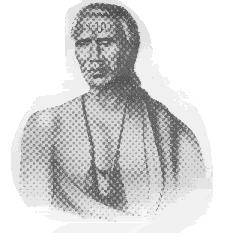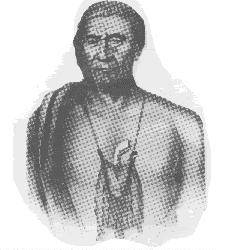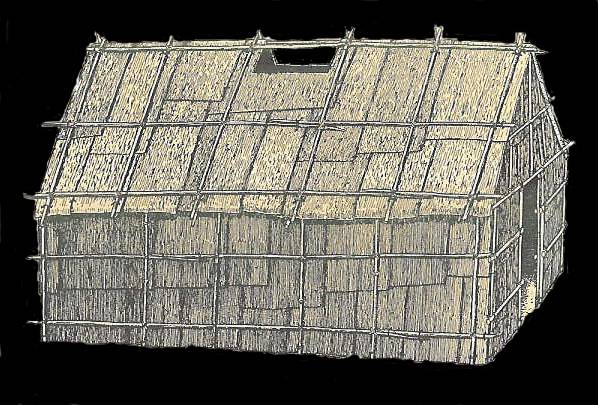

This page is designed to give a short overview of the history of the Lėnape people. For an extensive indepth study of the history, I strongly recommend the book, "Delaware Indians - A History" by C. S. Weslager.
At the time of the arrival of the Europeans the Lėnape occupied southern New York, eastern Pennsylvannia, New Jersey, and Delaware, and the eastern shores of Maryland. They were not a unified nation, but rather, were independent 'city-states" much like the ancient Greeks. Just as the ancient Greeks were known independently as Spartans, Athenians, and etc., the Lėnape tribes were known by many different names. Each village had it's own council and chief, and were self-governing, yet retained strong ties and bonds with the other villages.
The only ties that bound them were the ceremonial phratries and language. The closest thing to a political adhesiveness were the phratries, as they did have a chief and elders, but this hierarchy had power mostly in ceremonial matters, not so much in political matters. It wasn't until after the British seized control of colonial America, and only under the influence of the British, did the Lėnape people unite politically under a central council and a single chieftainship - and even that was not a perfect unification.
The English no longer wanted to deal with each tribe or village separately, as that had made it difficult and confusing for them in acquiring the land they wanted. To make their objective easier to obtain they urged the Lėnape, while in Ohio in 1750, to unite under a single "supreme sachem" and council. The English found a Lėnape chief who was all too ready to support the idea to become this "supreme sachem", and they influenced the people to choose him as their "king". For the first time, all the Lėnape tribes were now united under one "supreme king" and council, even though each maintained their own chief and council. Even with this unification, there remained a lot of division within the Lėnape population.
The Lėnape were one of the first peoples the Europeans met when they first set foot on what is now the U.S. The initial contacts were friendly but that soon changed. As fur was the fashion rage in Europe at the time, the Europeans sought to establish a fur trade in the new world. While the English and the French settled and controlled the majority of the northeast, the Dutch controlled the area which comprised the Lėnape homelands. The Swedes attemped to establish a strong presence in the fur trade, and a foothold in the New World. Of these four major players in the fur trade, only the Dutch had little interest in colonizing the New World. It was only the need to protect their trade interests which forced the Dutch to eventually establish permanent settlements and make efforts towards colonization.
The fur trade set tribe against tribe, and nation against nation, resulting in almost constant warfare in what had been previously a generally peaceful land. There were also many battles by the Indian peoples against the Europeans in retaliation of the brutal and unfair treatment the native peoples received at the hands of the Europeans.
The Swedes attempted to take over the Dutch fur trade interests and colonies at one point in time, but the Dutch prevailed and retained control. The Lėnape allied themselves with the Dutch, as the Dutch were less cruel than the Swedes. Eventually the English, and their Iroquois allies, defeated the Dutch for control of the northeast.
The French controlled Canada and attempted to make inroads into New York and the northeast, but were defeated by the British in the French & Indian Wars. The Haudenosaunee remained firm British allies, but the Hurons, and several Algonkian nations aligned with the French. The Lėnape people were split in their allegiences during this war, some aligning with the French, but most of the Lėnape declared neutrality and remained neutral throughout the war. As it proved out afterwards, the English were by far the most brutal and cruel of the European powers.
The British established an early policy towards the native peoples of "move or be destroyed", which later became a policy of "assimilation or annihilation" After the colonies won their independence from Great Britian, the American government retained and practiced this latter policy of "assimilation or annihilation". The reservation system employed against the western nations did not exist until 1862, when President Lincoln approved the planned originated by Gen. James Carleton (US Army, Dept. of New Mexico Territory) as an experiment. The first nations targeted for this "experiment" were the Dinč (Navaho) and the Chiracahua.
To effect the assimilation process, the political powers united with the churches and allowed the churches to establish mission settlements throughout the colonies. It was also a matter of policy for the political powers to establish settlements and "schools", but assign the administration of them to various church sects. The stated purpose of these schools and settlements were, as David Zeisberger, (one of the most famous Moravian missionaries) stated, "to destroy the Indian and make white men of them". A popular motto throughout these institutions was "kill the Indian - save the man". A number of these institutions even had that motto made into signs and hung within their confines.
In order to effect this assimilation these settlements and schools established strict and cruel rules, which were designed to destroy everything that was "Indian" about the individuals, and also to prevent any contact with outsiders (non-Settlement Indians). Below is a sampling of these rules. (For convenience sake I use the term settlement to include missions, church and governmental settlements and schools inclusively.)
....the people were required to abandon and denounce their heritage,
beliefs,traditions, and ceremonies.
....they were forbidden to speak their native language at any time
....they were given European names and forbidden to use their natural
names in any form
....they were not allowed to wear any of their native clothing, hair styles,
or accessories - they could wear only the clothes issued by
the settlement
....they were not allowed to associate with any non-settlement Indian
....they were not allowed to go hunting without being escorted by a missionary
or administrator)
....they were not allowed to marry without the consent of the missionaries
(or administrator)
....they were not allowed to trade or shop on their own
....the only employment allowed the people was to work the settlement's fields
and industries and to accept work assignments outside the settlement,
mostly as slave labor servants to local white farmers and tradesmen
....many of the young women were sold into marriage to whites (my own
grandmother was assigned as a servant to a local white farmer until she
was 15 years old at which time she was sold to my grandfather....an
American born son of Dutch immigrants)
These rules were strictly enforced, and punishment for disobedience was cruel, sometimes even brutal. Common punishments included incarceration, being denied food or medical care, torture, beatings, and being sold into slavery. In rare instances some "offenders" were even executed.
These institutions were not rare or isolated, they were prolific through the northeast colonies. The Moravians, Methodists, Presbyterians, and Jesuits were among the most widespread missions but were not the only sects to establish them. The various state governments and the federal government were just as prolific at creating settlements and schools in the effort to eradicate the presence of Indians. Carlisle School was but one school established for the purpose of assimilating the Indians. Dartmouth, Harvard, and a number of other well known northeast universities were originally established as Indian schools for the purpose of assimilating the Indian peoples.
From the early 1600's through the late 1800's the people were continually pushed westward from their homeland. This was accomplished through faudulent land deals and treaties, military force, intentional infestation of deadly diseases, slavery, and subversion. Some groups escaped into the mountains, some left and headed to areas where they thought they would be safe from the encroaching Europeans and their allies (the descendants of these bands are still scattered across the country), some were assimilated by other nations, and others were swallowed up by the ever advancing whiteman, but the main body of the Lėnape were continuously pushed westward.
The land grabs of the European and American governments also contributed to the destruction of Indian societies in the northeast. It was a common practice to acquire the territory of an Indian nation, tribe, or village through fraudulent treaties, forcibly driving the inhabitants out, or even by massacre. The Dutch and English are known to have traded small pox infested blankets with the intent to annihilate a village's population to acquire the land. Gnadenhutten, Schonbrun, and Salem are examples of a village's entire population being massacred. All three of these villages were Christian Lėnape villages which had laid aside their arms and sworn neutrality during the American Revolution. Pennsylvania militia brutally massacred every man, woman, and child who resided in these villages, after informing the inhabitants that they were there to escort the villagers to a safer location.
Other examples which illustrate how widespread this policy was throughout the northeast include the massacre of some 700 Pequots at Mystic, and of course let us not forget, the intended but failed plot to kill Massasoit and then seize Wampanoag lands using a feast of friendship as a ruse and trap. A feast which we now know as Thanksgiving.
As the Lėnape people were pushed ever westward as a result of the land grabs, they were often given land by other nations whose territory they entered. Often, there were inter marriages with these peoples and many Lėnape remained with their new families and tribes. As the westward expansion continued and caught up with the remaining Lėnape, once again they were forced off their new land and had to move. This cycle continued until two large Lėnape factions eventually reached Oklahoma, where one faction settled in Bartlesville and became a part of the Cherokee Nation. The other faction became separated and lost to history for a time, and were referred to as the "Absentees".
As a result of these policies there are, today, no full blood Lėnape in existence in the United States. Even the Delaware Nation of Western Oklahoma, the only federally recognized band of Lėnape, is comprised of a mixed blood population, which had been scattered and re-grouped before settling in Anadarko, Oklahoma. At one time they were known as the "Absentees".
In 1867 the Bartlesville group entered into a contract with the Cherokee Nation in which they paid the Cherokee approximately $280,00 (the actual amount has been reported to be between $250,000 and 350,000), renounced themselves as Lėnape, and became members of the Cherokee Nation. In return the Cherokee granted each head of household a parcel of land and status as members of the Cherokee Nation. Sometime afterwards members of the Bartleville group became dissatisfied and filed a legal action claiming the contract was not a contract, but rather that it was a treaty and came within the jurisdiction of federal treaty law. The group claimed that the treaty was void and unenforceable.
In 1894 the U.S. Supreme Court ruled that the agreement entered into by the Lėnape and Cherokee was in fact a contract to which both parties agreed, that all terms of the contract had been fulfilled by both parties, and was therefore valid and enforceable. As such it was subject to contract law, and was not a treaty nor was it under the jurisdiction of treaty law.
The Bartlesville group continued to protest and in 1903, the U.S. Supreme Court upheld the ruling of the 1894 court. In 1904 the government intervened in the dispute and in 1907, the government allotted each head of household a specific piece of land and auctioned the balance off to white bidders. Again, in 1979, the government officially denied the Bartlesville Lėnape recognition and upheld the two previous Supreme Courts rulings, and declared the group to be a part of the Cherokee Nation.
In 1996, the BIA extended the Bartlesville group recognition, and the group became known as the Delaware Nation of Oklahoma. In 2004 the 10th U.S. Circuit Court of Appeals ruled that the BIAs action was arbitrary and capricious, and was without legal basis. The court upheld the 1894, 1903, and 1979 decisions, stripped the group of its illegal and arbitrary and capricious status, and returned them to the status of being members of the Cherokee Nation. In 2005, the court issued a mandate re-affirming its 2004 ruling, ordered all federal funds to cease immediately, and all programs funded by federal funds to be terminated and closed out by March 25, 2005.
Many Lėnape people refused to move or to leave their homelands in New York and Pennsylvania, and fled into the mountains or to the settlements and missions. Those that fled to the settlements and missions became victims of the assimilation policies. Some of the people established covert communities deep in the mountains of eastern Pennsylvania and southern New York, communities which remained intact only until they were discovered or the land was desired by state or federal authorities. One of the most famous of these communities was Indiantown Gap, which was forcibly taken by the US Army in the 1930's. There are survivors, and descendents of the survivors, of the take-over of Indiantown Gap still alive today who relate the horror of the attack on their village.
Most Lėnape today, are assimilated into the mainstream society or into other Indian cultures. Most have long ago forgotten, or forsaked, their Lėnape blood, heritage, and culture. However there are those of us who still reside in, or maintain our ties to, our homelands, and who are working hard to preserve our traditions, our culture, and our existence as a people.
 Lapawinso
Lapawinso Tischohan
TischohanThe earlist known portraits of Native Americans are these paintings of Lėnape chiefs Lapawinso and Tishcohan. They were both painted around 1750 by Gustavus Hellius.

Loved and respected above all others, Tamanend was the greatest of all Lėnape chiefs. Tamanend was known for his wisdom, honesty, fairness, charity, and hospitality. Because of his great wisdom and the fact that no ill or evil ever befell him, it was believed that he was favored by the Creator and could speak directly with the Creator.
Tamanend had two sons, Yakwihon and Kwčnamčkkwģd. There are no known records of Tamanend after 1697, and it is believed he died in 1698.
Tamanend made the earliest treaties with William Penn, only to be taken advantage of and not paid the agreed upon amounts of goods and supplies promised him for his people.
Tamanend was respected and admired by the white society to such a degree that he was chosen as the Patron Saint of America - St. Tamany. Tamany Hall, the Tamany Society, and many cities and institutions are named in his honor.

The modern day Lėnape are said to be spread among three clans, Wolf, Turtle, and Turkey. This clan structure however is not accurate, and is in reality a corruption of the historical social structure of the Lėnape people. The corrupted three clan system of today is the result of confusing and combining dialectal and ceremonial divisions of the people and recasting those divisions into the three clan structure.
Within any clan system it is forbidden to marry within one's own clan. This practice is intended to unite the clans through bloodlines insuring their unity to each other. Such a marital prohibition would require a large number of clans to insure the continued social structure of a people. The survival of a people would be nearly impossible with just a limited three clan structure.
Historically, the Lėnape were divided into three ceremonial divisions, or phratries. These phratries were the Tłkwsit (Round Foot or Wolf), Płkuwąnku (Turtle), and Pėle (Turkey). These phratries contained a total of thirty-four known clans.
The Lėnape were also divided into three dialectal divisions, Monsi, Unami, and Unilachtigo, which were also known as Wolf, Turtle, and Turkey respectively. Although these descriptions of the dialectal divisions coincide with the titles of the ceremonial divisions, or phratries, they actually have no bearing on the phratry/clan structure. It is this coincidence that has contributed to the confusion and corruption of the Lėnape clan system. It is from the obfuscation of the phratries, or ceremonial divisions, and the dialectal divisions that the modern day "clans" are erroneously classified.


